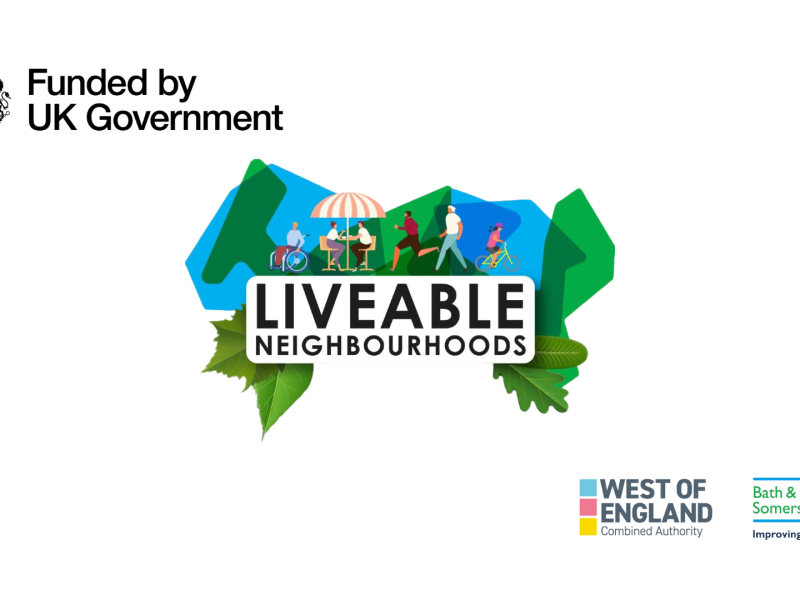From the Council: Bath & North East Somerset Council proposals to secure the funds required to develop 11 Liveable Neighbourhood schemes have been put forward in a full business case to the West of England Mayoral Combined Authority.
A detailed report, which sets out a range of interventions drawn up by the council together with the 11 communities, will be considered by the West of England Combined Authority Committee when it meets on September 20.
Under the Liveable Neighbourhood (LN) programme, the council aims to reduce the impacts associated with excessive traffic in residential areas, such as through traffic, congestion, and speeding, and to create environments where it is easier, safer, healthier, and more attractive to walk, wheel and cycle.
Councillor Manda Rigby, cabinet member for Highways, said: “The proposals for each of the Liveable Neighbourhood areas are a result of ongoing engagement with residents and ward councillors since 2021, with the purpose of identifying traffic-related issues, developing a longlist of ideas to help, and then prioritising the interventions that meet our LN objectives, and which represent the most benefit to communities for the money invested.
“In the full business case we have set out our proposals for final packages of measures which we hope to develop over the next two years, subject to detailed design work, funding, further engagement with communities on detailed designs and, where appropriate, experimental trials.
“We want the outcomes of Liveable Neighbourhood scheme to support the council’s wider policies to tackle the climate emergency, improve travel choices and create healthier, safer active travel routes. We also want to reduce the need for short car journeys – of which 42 percent of all journeys under 3km in Bath are in private vehicles – by offering attractive, safe alternatives.”
The 11 areas where the council is proposing a package of measures include:
- Church Street and Prior Park Road
- Whitchurch Village and Queen Charlton)
- Southlands Area (Weston)
- New Sydney Place and Sydney Road
- Lyme Road and Charmouth Road area
- Lower Lansdown and The Circus
- Temple Cloud
- Pulteney Estate area
- London Road and Snow Hill area
- Entry Hill, Bath
- Chelsea Road area
This includes areas where through-traffic restrictions are now in place, being trialled, or in the pipeline as part of the council’s LN pilot programme.
The types of interventions included in the FBC include, among others:
- Improvements to pavements and footways, including the introduction of continuous crossings on side roads
- Improvements to crossings and traffic signals
- Through-traffic restrictions and traffic calming where through-traffic, vehicle congestion and speeding is an issue
- The narrowing of junctions to slow approaching traffic
- Improved cycle infrastructure
The council originally planned to develop 15 LNs during this first phase, but early cost estimates required the council, in discussion with the relevant ward councillors, to reduce the scope to 11 areas with fewer interventions.
The council hopes to progress more of the ideas put forward by communities in all 15 areas either through future funding or via other projects. The areas not going forward as part of this business case are Mount Road area, Oldfield Lane and the Avenues area, Morris Lane and Bannerdown Road area, and the Egerton Road and Cotswold Road area.
The council, through the full business case, is now requesting the remaining £3.78m of the £5.1m funds originally earmarked for the project from the UK Government’s City Regional Sustainable Transport Settlement fund, plus an additional £1.81m which it estimates it needs to deliver the programme in full.
Should the West of England Combined Authority Committee approve the submission, and once the council has formally accepted the funds, the council will engage the 11 communities on both the proposals and the final, detailed designs before it makes final decisions. If appropriate, the council will run experimental trials which allow the public to feedback their views on measures such as through-traffic restrictions, for a minimum of six months, while the council monitors any impacts on traffic and air quality monitoring. Some trials are already underway under a pilot programme.
The West of England Mayoral Combined Authority is responsible for distributing the UK Government’s City Regional Sustainable Transport Settlement (CRSTS) funds to viable schemes in the region. Its members, including the West of EnglandMayor and leaders from the Mayoral Combined Authority’s three constituent councils: Bath & North East Somerset Council, Bristol City Council and South Gloucestershire Council, will consider the request for funding in the context of how well the proposals align with the aims of the CRSTS programme – which includes the creation of a more sustainable, less impactful transport system – and the potential benefits to the 11 communities.
Details of the committee meeting on 20 September are available on the West of England Mayoral Combined Authority’s website. There will be a live webcast of the meeting.
The Committee’s report on the FBC is on page 45 of the Agenda Report Pack which includes a link to the Liveable Neighbourhood Full Business Case.
More details on the council’s Liveable Neighbourhood programme, including the pilot experimental trials, are available at www.bathnes.gov.uk/liveableneighbourhoods.


